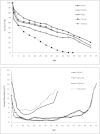Evolution in health and medicine Sackler colloquium: Evolution of the human lifespan and diseases of aging: roles of infection, inflammation, and nutrition
- PMID: 19966301
- PMCID: PMC2868286
- DOI: 10.1073/pnas.0909606106
Evolution in health and medicine Sackler colloquium: Evolution of the human lifespan and diseases of aging: roles of infection, inflammation, and nutrition
Abstract
Humans have evolved much longer lifespans than the great apes, which rarely exceed 50 years. Since 1800, lifespans have doubled again, largely due to improvements in environment, food, and medicine that minimized mortality at earlier ages. Infections cause most mortality in wild chimpanzees and in traditional forager-farmers with limited access to modern medicine. Although we know little of the diseases of aging under premodern conditions, in captivity, chimpanzees present a lower incidence of cancer, ischemic heart disease, and neurodegeneration than current human populations. These major differences in pathology of aging are discussed in terms of genes that mediate infection, inflammation, and nutrition. Apolipoprotein E alleles are proposed as a prototype of pleiotropic genes, which influence immune responses, arterial and Alzheimer's disease, and brain development.
Conflict of interest statement
The authors declare no conflict of interest.
Figures

References
-
- Finch CE, Stanford CB. Meat-adaptive genes and the evolution of slower aging in humans. Q Rev Biol. 2004;79:3–50. - PubMed
-
- Finch CE. The Biology of Human Longevity. Inflammation, Nutrition, and Aging in the Evolution of Lifespans. San Diego: Academic; 2007.
-
- Oeppen J, Vaupel JW. Demography. Broken limits to life expectancy. Science. 2002;296:1029–1031. - PubMed
-
- Finch CE, Crimmins EM. Inflammatory exposure and historical changes in human life-spans. Science. 2004;305:1736–1739. - PubMed
-
- Caspari R, Lee SH. Is human longevity a consequence of cultural change or modern biology? Am J Phys Anthropol. 2006;129:512–517. - PubMed
Publication types
MeSH terms
Substances
LinkOut - more resources
Full Text Sources
Medical

